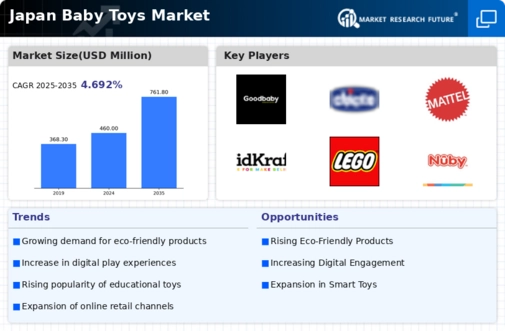The baby toys market in Japan is characterized by a dynamic competitive landscape, driven by innovation, consumer preferences, and technological advancements. Major players such as Mattel (US), LEGO (DK), and VTech (HK) are actively shaping the market through strategic initiatives. Mattel (US) focuses on expanding its product lines with a strong emphasis on sustainability, while LEGO (DK) continues to innovate with eco-friendly materials in its construction toys. VTech (HK) is leveraging digital technology to enhance learning experiences, positioning itself as a leader in educational toys. Collectively, these strategies contribute to a competitive environment that prioritizes innovation and sustainability, reflecting changing consumer expectations.
Key business tactics within the market include localizing manufacturing and optimizing supply chains to enhance efficiency and responsiveness. The competitive structure appears moderately fragmented, with several key players holding substantial market shares. This fragmentation allows for diverse offerings, yet the influence of major companies remains significant, as they set trends and standards that smaller firms often follow.
In October 2025, LEGO (DK) announced the launch of a new line of biodegradable building blocks, marking a significant step towards sustainability in the toy industry. This initiative not only aligns with global environmental goals but also caters to the increasing consumer demand for eco-friendly products. The strategic importance of this move lies in LEGO's ability to differentiate itself in a crowded market, appealing to environmentally conscious parents.
In September 2025, VTech (HK) unveiled an innovative smart toy that integrates AI technology to personalize learning experiences for children. This development underscores VTech's commitment to enhancing educational play, potentially setting a new standard for interactive toys. The strategic significance of this innovation is profound, as it positions VTech at the forefront of the educational toy segment, likely attracting tech-savvy consumers.
In August 2025, Mattel (US) entered a partnership with a leading sustainability organization to promote eco-friendly practices in toy production. This collaboration aims to reduce plastic waste and enhance the company's reputation among environmentally conscious consumers. The strategic importance of this partnership lies in its potential to strengthen Mattel's brand image while addressing growing concerns about environmental sustainability in the toy industry.
As of November 2025, current competitive trends in the baby toys market are increasingly defined by digitalization, sustainability, and the integration of AI technologies. Strategic alliances among companies are shaping the landscape, fostering innovation and collaboration. Looking ahead, competitive differentiation is likely to evolve from traditional price-based competition to a focus on innovation, technological advancements, and supply chain reliability. This shift suggests that companies prioritizing these aspects will be better positioned to capture market share and meet the evolving demands of consumers.

























Leave a Comment